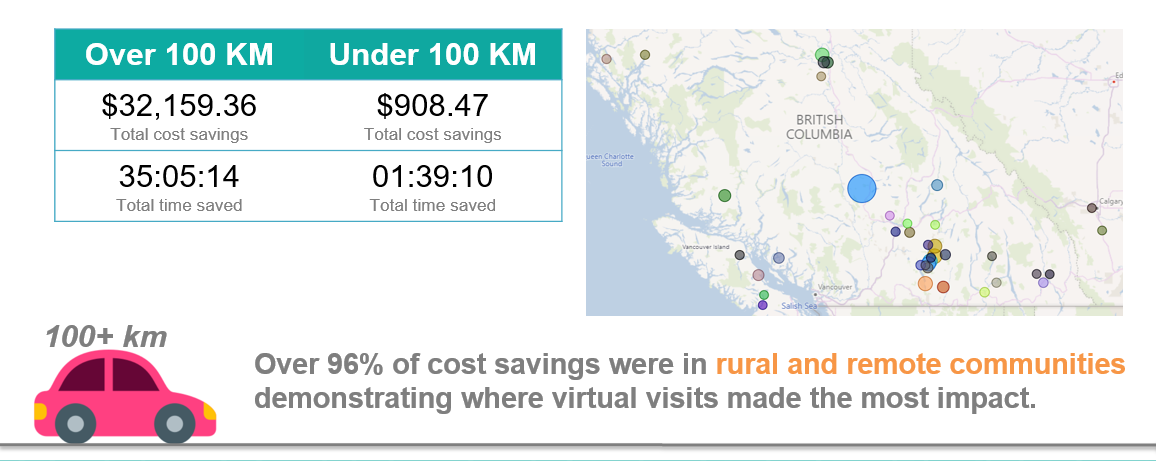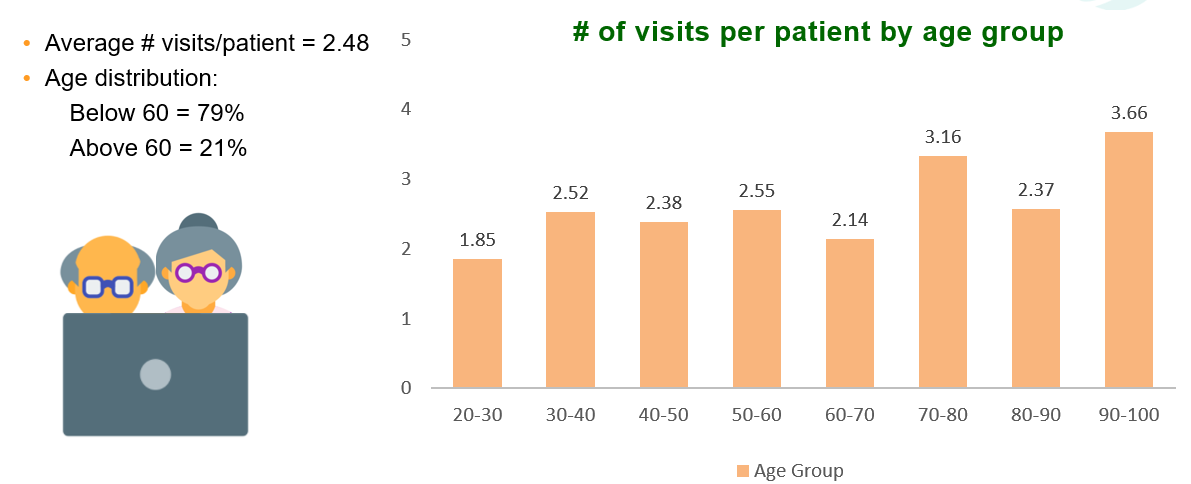What if we could get a snapshot of the tangible benefits that virtual health visits provide to patients? What if, instead of going through rows of data collected, we could see it collected and contextualized in one clear image?
Thanks to assistance from PHSA’s Information Management/Information Technology Services (IMITS) and Data Analytics, Reporting and Evaluation (DARE), PHSA’s Office of Virtual health (OVH) has created an interactive dashboard by leveraging the data from one of its pilot projects prior to the pandemic.
“The virtual health visit pilot project was launched back in 2019 with the goal to bring specialized care into patients’ homes. We used project data to inform the analysis and make a patient benefit realization dashboard to bring the story to life.” says Ying Jiang, senior leader with the OVH who led the patient benefit realization dashboard from conception to completion.
The dashboard analyzed 977 visits completed by 421 patients. It is estimated that virtual health visits saved the participating patients a total of 816 travel hours and $33,585 travel costs over 5,514 km. On average, it saved each patient 1 hour and 39 minutes, although generally patients in more remote communities receive the greatest benefit given the increased distance they must travel to see a specialist in person.
The dataset covers close to 1000 visits conducted by over 400 patients from 15 clinical programs for a variety of clinical needs; it can be considered a random sample of the diverse population seeking specialized care in B.C. The largest part of the dashboard is the interactive map, which is covered in multi-coloured dots all over the province and as far afield as the Yukon and Alberta. The dots, located based on the prefix of the patients’ postal code, range in size which corresponds to the number of virtual health visits held in each general location, demonstrating the reach of virtual health visits in a visual way.
The data contains the first three-character postal code to estimate the patient’s location for map visualization. This is also used as the base to calculate distance. Time and cost savings were estimated by the distance between patient locations in relation to clinical facilities. The estimated benefits on the dashboard are also a very conservative calculation given that it’s not possible at this time to estimate exact travel cost and time based on factors like precise road conditions while preserving patient confidentiality.
“One of the biggest challenges in evaluating virtual health initiatives is the ability to demonstrate an improvement on health outcomes,” notes Julie Wei, senior leader at the Office of Virtual Health. “Sometimes it is nearly impossible to attribute the impact of virtual health on outcomes in such a short period of time. To be able to demonstrate the immediate impact from the patient perspective using time and dollars saved is an effective way to show decision-makers the value of virtual health.”

With support, age not a barrier to adoption
A common misconception is that seniors will find virtual health visit technology hard to understand or use.
“The first analysis we did with the dashboard was to look at the average number of virtual appointments per patient by age group,” says Jiang. “In this dataset, utilization is very similar across all age groups. We don’t see any patterns or correlation between age and number of visits. We were really glad to see that seniors are not left behind when it comes to virtual health visits.”

Health equity more important than ever
Challenges in using virtual health visit technologies do exist, such as device access, connectivity, and technological literacy. Jiang emphasizes that we have to take every possible action to make virtual health visits accessible to all, and notes many health care providers do their part to support their patients in having virtual health visits.
“One clerk offered practice calls to patients in need,” said Jiang. “She had laminated a printed screenshot of the interface of the software so when the patient appears on the screen and can see her but, for example, they don’t know how to adjust the audio, she holds up the image and points to the right icons to access to fix the problem. They are the unsung heroes in health care.”
Practice calls are not necessarily a sustainable solution when we scale virtual health visits upward. Now, the citizen support desk has been launched to support patients in a more coordinated and sustainable manner. The Office of Virtual Health has also developed multiple patient resources, such as help guides and videos. These are important actions to promote access as we continue to enable and embrace virtual health visits.
Making the impact through collaboration
The virtual health visit demonstration project providing data for the dashboard was a collaborative effort between PHSA and various clinical programs. The dashboard was built in partnership with IMITS and the DARE office, who provided guidance on formulating the cost calculation into the dashboard.
“With support from our partners at IMITS, we were able to bring data to an analytics environment that is interactive,” says Wei. “We just need to feed new data collected on a regular basis to display automatically the travel distances avoided and estimated cost-savings.”
Currently, the dashboard is based on data from this project, but the possibility to feed in different datasets is available. As it is, fresh data is added to this dashboard each quarter.
Virtual health visits are aimed to help improve access, patient experience and make health care more cost efficient. There are always challenges in demonstrating cost savings. The benefit realization dashboard can help health care planners understand the benefits of using virtual health in order to continue to promote and integrate virtual health into care delivery models and modernize the way we access and deliver care.
